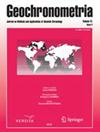Can we distinguish between tree-ring eccentricity developed as a result of landsliding and prevailing winds? consequences for dendrochronological dating
IF 0.9
4区 地球科学
Q3 Earth and Planetary Sciences
引用次数: 11
Abstract
Abstract The aim of our study was to compare patterns of tree-ring eccentricity developed in Norway spruce trees as a result of landsliding with the one caused by the prevailing wind (in 2 study sites), and with the normal growth of trees (in 2 reference sites). We sampled 20 trees per study site and 10 per reference site. Two cores were taken from each tree (120 cores in total) from the upslope and downslope, windward and leeward sides of stems. Ring widths measured on opposite sides of stems were compared using the method of percent eccentricity index. Graphs of the index obtained for individual trees were analysed. Statistical indicators were calculated for a percent eccentricity index. Disturbance events were dated and the response index was calculated. The results show that the patterns of eccentricity developed as a result of the prevailing winds and due to landsliding differ from one another and from the reference sites. The results suggest that the impact of the prevailing wind on tree growth is more severe than the impact of landsliding. The difference may result from the slow-moving character of the landslide under study. The results, however, indicate that wind impact should be taken into account in dendrogeomorphic research and that the impact of mass movements should be considered in dendroecological studies on wind.我们能区分由滑坡和盛行风造成的树木年轮偏心吗?对树木年代学的影响
摘要我们研究的目的是将挪威云杉树因滑坡而形成的树木年轮偏心率模式与盛行风引起的模式(在2个研究地点)以及树木的正常生长模式(在两个参考地点)进行比较。我们对每个研究地点的20棵树和每个参考地点的10棵树进行了采样。从每棵树的上坡和下坡、向风和背风侧取两个岩芯(共120个岩芯)。用偏心率指数法比较了在茎相对两侧测得的环宽度。对获得的单株指数图进行了分析。统计指标是为离心率百分比指数计算的。确定干扰事件的日期,并计算响应指数。结果表明,由盛行风和滑坡形成的离心率模式彼此不同,也与参考地点不同。结果表明,盛行风对树木生长的影响比滑坡的影响更严重。这种差异可能是由于所研究的滑坡的缓慢运动特征造成的。然而,研究结果表明,在树木地貌研究中应考虑风的影响,在树木生态学研究中应对风的影响进行考虑。
本文章由计算机程序翻译,如有差异,请以英文原文为准。
求助全文
约1分钟内获得全文
求助全文
来源期刊

Geochronometria
地学-地球科学综合
CiteScore
2.20
自引率
0.00%
发文量
1
审稿时长
>12 weeks
期刊介绍:
Geochronometria is aimed at integrating scientists developing different methods of absolute chronology and using them in different fields of earth and other natural sciences and archaeology. The methods in use are e.g. radiocarbon, stable isotopes, isotopes of natural decay series, optically stimulated luminescence, thermoluminescence, EPR/ESR, dendrochronology, varve chronology. The journal publishes papers that are devoted to developing the dating methods as well as studies concentrating on their applications in geology, palaeoclimatology, palaeobiology, palaeohydrology, geocgraphy and archaeology etc.
 求助内容:
求助内容: 应助结果提醒方式:
应助结果提醒方式:


